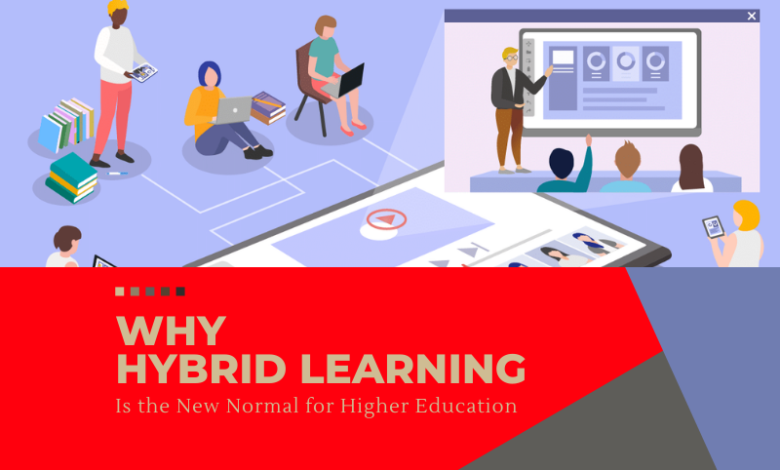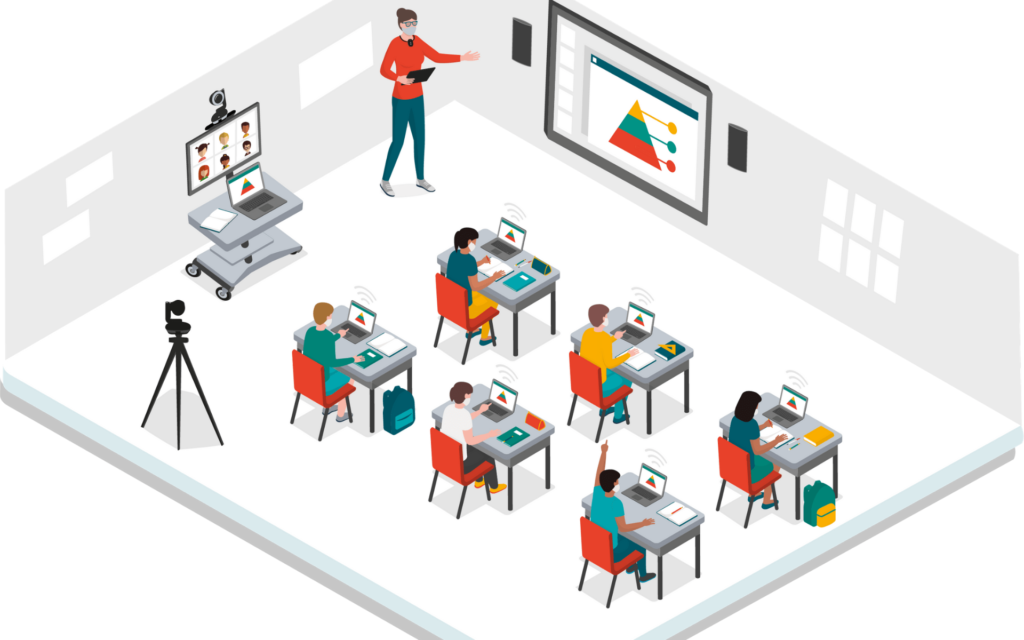Why Hybrid Learning Is the New Normal for Higher Education

While all levels of education have changed dramatically, higher education has seen the most long-lasting of these changes, and this is arguably a field that has certain new normal ways of operation that will define the future of the sector. The core elements of higher education have not changed, and the overall accepted aims remain to educate, research, and provide a service to society. Yet the manner in which this is now being done, and will be done in the future, has definitely changed.
The technological innovation around learning that we have seen has resulted in real changes to higher education. However, even this technology may not have the solution to a systemic problem of non-completion, dropping numbers of lower-income learners in higher education, and the overall drop in desirability of higher education. The argument here is that it is only through a hybrid form of learning that we will be able to solve some of these issues.
The world is changing more rapidly than ever before, and there is a feeling of confusion and uncertainty in the labor market, which has then seen an associated rise in the number of people retraining and studying to secure more sustainable, relevant employment.
It is thus a sector in flux, and there is a requirement for a re-think of various key aspects of the US higher education system. This has been an ongoing process, and such re-imagining of US higher education will require a clear understanding of some of the recent changes.
The main changes are listed below, and it is in the amalgamation of some of these that the hybrid learning environment has come to the fore.
- Online learning – This is where the entire course or degree is presented online using a mix of methodologies. From webinars and videos to live-streamed lectures, it is all in the cloud, and learners can be based anywhere. There are now numerous online learning platforms, and universities, colleges, and schools have also democratized their learning and now most, including some of the best universities in the land, offer their courses online. From simple ‘how to’ YouTube videos to more complex theoretical subjects like physics and quantum computing, it can all be read, accessed, and studied online. By 2025 this will be a $350 billion market and is expected to continue to grow in the long term.
- Remote learning may be online and also simply completed via mail, as in the more traditional means of distance learning and teaching. Assignments are completed and sent in to be marked, and again the learners can be anywhere in the world. It is true that most remote learning is also now online learning, but there are still courses and colleges that have an offering for those who are remote and not necessarily online. Remote learning wasn’t the favorite mode of study when the pandemic pushed higher education online, and many students took a break from their studies rather than going fully remote. The technology has been improved, and as the systems and processes become more student and learner orientated, remote learning as an option is gaining popularity and seeing more widespread uses.
- The virtual classroom is where a real-time live classroom is set up in the cloud, and learners can attend, interact, and learn. It is generally offered via a video conferencing app or program integrated with screen sharing and virtual whiteboard features. Recordings are also made for students to be able to access after the lesson. Although the virtual classroom was seen as the answer for higher education to be able to spread and grow outside the brick and mortar institutions, there were also various virtual classroom challenges around creating standards and ethical guidelines for such instruction. Teachers and learners needed to be prepared for the level of intrusion the virtual classroom creates, and as the technology develops, it has become more professional and widely accepted as an important teaching and learning resource.
- Traditional learning – This still remains an available option for higher education and will arguably remain an option so that brick-and-mortar institutions continue to exist. Face-to-face learning will never expire or come to an end; it is simply how it is used that is changing. The practical aspects of various disciplines or subjects cannot all be done online or remotely, and as such, this will continue to be an essential component of the higher educational process.
It is the mix of all these types of education, a mix of the innovative technology with the traditional forms of education that has become known as hybrid education and learning and is arguably the future of all education.
Just as hybrid working has become the norm, so, too, has the idea of a versatile education system that includes remote, virtual, practical placements and classroom-based training and education. This article will examine one of the main forms of the new normal modes of training and education, the hybrid learning model.
What is hybrid learning?
This is where some learners attend in person, and others are at these lessons virtually and are then taught at the same time. Hybrid learning is additionally a mix of face-to-face and online learning dependent on the material itself. The best parts and uses of face-to-face are combined with online and virtual learning for all students. This is a process that must be well-considered and cannot simply be about presenting half the curriculum in the classroom and the other half online. Both online and face-to-face learning have their downfalls, and the idea of hybrid education is to bridge this gap and to provide a mode of learning that caters more widely. It offers digital, interactive, and engaged teaching in a classroom, with the same experience for those who are attending remotely.
There is certain material that cannot simply be presented online, and if it is, it may need various interactive additions. It is in these considerations that some of the downfalls of the hybrid learning and teaching model may be pinpointed.
Hybrid education and training examples that work:
It is useful when creating a clear understanding of a topic to present a real-life example, and those below clearly show how hybrid learning is used for successful education.
- Nursing has been one of the main educational sectors where hybrid learning has taken off in a major way. The demand for nurses means that there is no way that all these nurses can be trained in a face-to-face fashion. This means that there are professional accelerated nursing programs that provide notable examples of hybrid teaching successes. The theoretical aspects, as well as the practical aspects of nursing, were seen as the perfect mix or blend, suited to the training and teaching using a mix of face to face, virtual instruction, hypermedia resources combined with other innovations to make for an interactive and yet focused means of instruction for senior nursing students as well as those new to the field.
Nursing is thus one of the accepted fields of study where hybrid learning has proven its effectiveness and will form a model for other similar aspects of modern education.
- Technology is one of the sectors where hybrid learning has yielded results. The technological know-how is taught using video and live real-time practical lessons. Then there is an actual practical component that is also capable of being done online, using the most advanced tech there is in automation, artificial intelligence, and virtual reality.
The technology and the cloud computing available means that there is an actual classroom, as well as remote classrooms and other locations that can be linked through the cloud. This also allows for remote live streaming, smart whiteboard collaboration, and remote interaction.
Pros and cons of hybrid learning
Pros:
- Flexibility allows students to attend when they can or watch pre-recorded videos, webinars, and lectures. The flexibility also relates to the fact that the mode or subject presentation methods can change based on the course or the specific material presented. This thus improves the level of customization of all courses.
- Allows for better time management – the productive use of student time has been one of the main challenges in higher education. Most students have noted that improved time management would improve their grades. Hybrid learning, where students can access the synchronous class, remote students can choose to watch or schedule the lecture into their available time.
- Greater accessibility – not all those who want to attend higher education or further their studies can actually go to the lectures or physically attend classes. Being able to participate with others in the classroom from any location and at any time means that access is vastly improved.
More variety with a wider choice on offer as students are no longer bound by distances, borders, and in some cases, even language. - Better use of resources can be achieved by sharing online – the use of online chat forums and tutors means that there is a possibility to share more in real-time than there would be in the classroom.
Cons:
- Some material is not suited for online teaching, and as such, those who cannot attend the actual classes may not be able to benefit from all the training.
- Limited social interaction for those who are remote and are unable to attend in person. Although the online and virtual interaction has improved, it is still noted that while access to learning and resources is improved, the ability to interact in person and debate and question in such settings are essential components of the higher education experience. The hybrid course requires students to post and participate in an ongoing fashion, and for many, this can take more effort than the physical interaction in real classroom setups.
- Internet access is essential and can be a disadvantage to those who do not have a reliable and stable internet connection. Furthermore, the cost of downloads and the data required to watch lectures and participate in virtual learning environments can be prohibitive for many.
How to create the perfect hybrid learning model
A good hybrid learning model should look to deal with the disadvantages as aforementioned and promote the pros of this type of learning. The key, however, will be flexibility and the ability to adapt to learn and student needs, as well as the demands from industry and the jobs market.
Have a clear set of goals, short term, medium term, and long term. Remember that the overall course outline and description won’t necessarily need to change; it’s just how you present it that needs planning.
Determine which are the definite ‘in person’ sections of the course. These will be those elements of teaching that cannot be done online. Generally used for synchronous group discussions and debates.
Plan the online portion of the course – assignments will be done virtually, and all other elements not covered by the face-to-face sections will need to be covered online.
Develop and source appropriate content -the course material may all exist, and the face-to-face components should be determined and planned. The material that needs to be presented online will then need to be developed.
Tried and tested – any hybrid learning using modern technology for virtual lessons and facilitating sharing of resources in the cloud will require the infrastructure to be established and tested before any students are using the product.
As with any new educational development, the proof will be in the skills base that is developed from this type of learning. However, it is here to stay, and it is imperative to understand what it is and how hybrid learning is the future for higher education.
Conclusions
Most schools, colleges, and institutions of higher learning have opted for the hybrid learning model. This has, indeed, been an option for many years in higher education, but it has only been in the last few years as the pandemic has caused institutions of higher learning to emphasize and promote the functionality and importance of hybrid learning. If you are looking to study further or are looking for the perfect course, you must investigate the hybrid learning options, as these are proving to be some of the best ways to learn and to access a wider range of courses than ever before.







